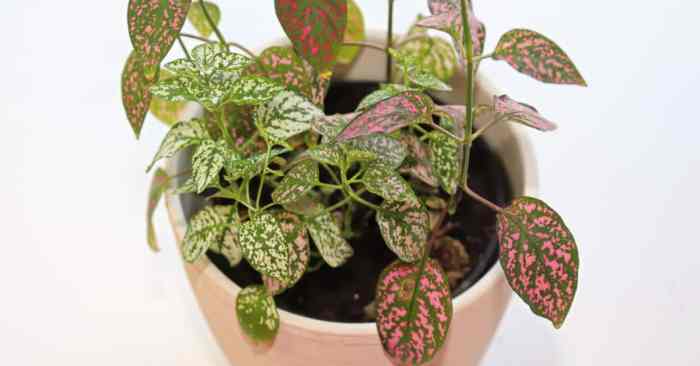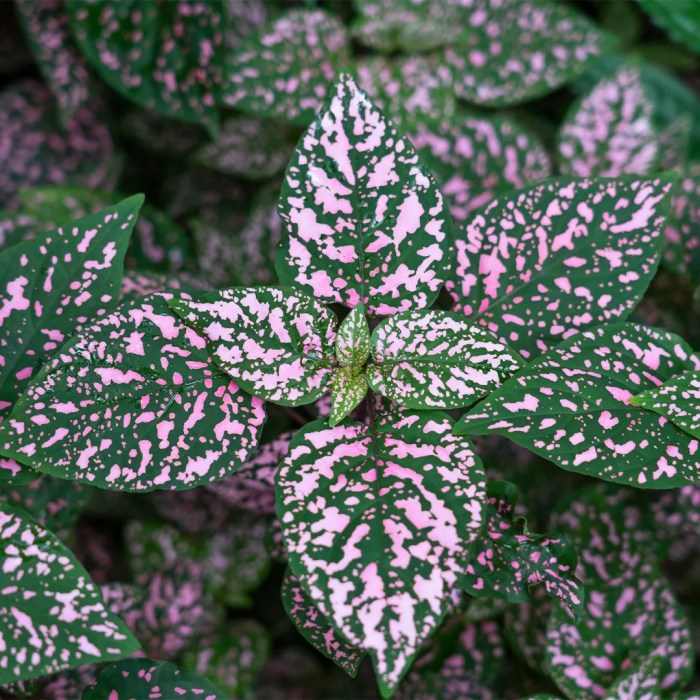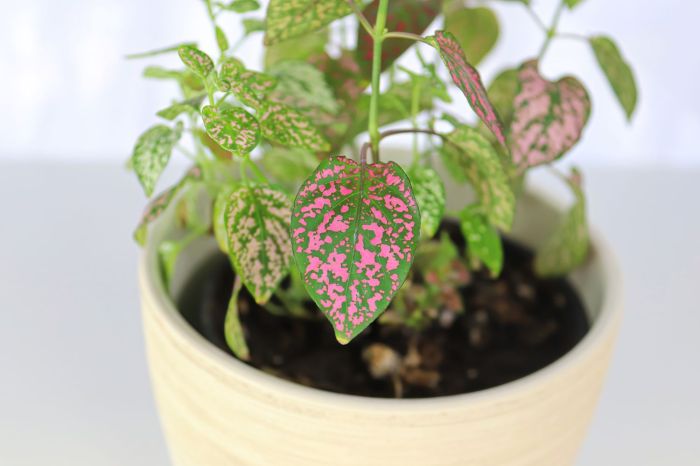Can You Propagate Polka Dot Plant in Water?
Polka Dot Plant Propagation in Water
Can you propagate polka dot plant in water – The polka dot plant, Hypoestes phyllostachya, is a popular houseplant prized for its attractive foliage speckled with vibrant pink, red, or white spots. Its relatively easy propagation makes it a favorite among plant enthusiasts. Propagating polka dot plants offers several advantages, including the ability to expand your collection at minimal cost and the satisfaction of nurturing new plants from cuttings.
While several methods exist, including propagation from seeds and stem cuttings in soil, water propagation offers a simple and effective approach, allowing for close observation of root development.
Introduction to Polka Dot Plant Propagation
Polka dot plants are characterized by their ovate, slightly hairy leaves displaying distinctive spots. These spots vary in color depending on the cultivar, ranging from pale pink to deep crimson. The plant’s compact habit and vibrant foliage make it a visually appealing addition to any indoor space. Propagating polka dot plants allows for easy expansion of your collection, sharing with friends, or simply enjoying the process of nurturing new life.
Methods include seed propagation, stem cuttings in soil, and water propagation, each with its own advantages and disadvantages.
Propagating Polka Dot Plants in Water: A Step-by-Step Guide
Water propagation requires minimal materials and provides a clear view of root development. The process is straightforward and highly successful with polka dot plants.
- Gathering Cuttings: Select healthy, non-flowering stems approximately 4-6 inches long. Use a sharp, clean knife or pruning shears to make a clean cut just below a node (the point where leaves or branches emerge from the stem).
- Preparing the Cuttings: Remove the lower leaves from the cutting, leaving only the top 2-3 sets of leaves. This prevents rot in the water.
- Preparing the Water: Use clean, room-temperature water. Avoid using tap water that may contain chlorine or other chemicals harmful to the cuttings. Adding a small amount of rooting hormone (optional) can boost root development.
- Placing Cuttings in Water: Place the cuttings in a clean container filled with water, ensuring that only the lower portion of the stem is submerged. The leaves should remain above the waterline.
- Providing Optimal Conditions: Position the container in a location with bright, indirect light. Avoid direct sunlight, which can scorch the leaves. Maintain a warm temperature (around 70-75°F).
Water Container Comparison

Source: justinboey.com
| Material | Size | Advantages | Disadvantages |
|---|---|---|---|
| Glass | Small jar, vase | Allows for easy observation of root development; aesthetically pleasing. | Can be prone to algae growth; requires more frequent water changes. |
| Plastic | Small cup, container | Less prone to algae; generally more durable. | Doesn’t allow for as easy observation of root development. |
| Ceramic | Small pot | Aesthetically pleasing; can retain moisture better than glass. | Can be heavier; may be more expensive. |
Troubleshooting Common Issues
Several problems can arise during water propagation. Addressing these issues promptly can significantly improve success rates.
- Root Rot: Caused by excessive moisture or stagnant water. Solution: Remove affected cuttings, change the water frequently, and ensure proper aeration.
- Fungal Growth: Appears as fuzzy patches on the stems or water. Solution: Discard affected cuttings, use clean water and containers, and avoid overcrowding.
- Wilting: Indicates insufficient water or excessive sunlight. Solution: Adjust watering and provide indirect light.
Preventative measures include using clean water and containers, avoiding overcrowding, and ensuring proper ventilation. Water changes should be performed every 2-3 days to prevent bacterial growth and maintain water clarity.
Transitioning to Soil, Can you propagate polka dot plant in water

Source: picturethisai.com
Once the cuttings have developed a robust root system (typically 2-4 weeks), they are ready for transplanting into soil. This transition requires careful handling to avoid damaging the delicate roots.
- Preparing the Potting Mix: Use a well-draining potting mix suitable for houseplants. A blend of peat moss, perlite, and vermiculite is ideal.
- Transplanting: Gently remove the cuttings from the water and plant them in individual pots, burying the roots to the same depth they were in the water.
- Post-Transplant Care: Water the newly potted plants thoroughly and provide bright, indirect light. Continue to monitor for signs of stress or disease.
Plants propagated in water generally require similar care to those started directly in soil, although those started in water might require a slightly more gradual acclimation to full sunlight to avoid leaf scorch.
Illustrative Examples

Source: thespruce.com
Healthy roots developing in water appear white, firm, and numerous. They will extend from the nodes of the stem, creating a fibrous root system. A successfully propagated polka dot plant will show vigorous growth, with new leaves emerging and the plant developing a fuller, bushier habit. The leaves will retain their characteristic speckled coloration. In contrast, unhealthy cuttings will exhibit signs of wilting, yellowing, or rotting.
The stems may become mushy, and root development will be stunted or absent. The leaves might display discoloration or spotting, different from the normal characteristic spotting.
Questions and Answers: Can You Propagate Polka Dot Plant In Water
How long does it take for polka dot plant cuttings to root in water?
Generally, you can expect to see roots developing within 2-4 weeks, depending on factors like temperature and light exposure.
What happens if my polka dot plant cuttings start to wilt?
Wilting often indicates insufficient water or too much direct sunlight. Adjust your watering schedule and provide some shade.
Can I use tap water for propagation?
It’s best to use filtered or distilled water to avoid chlorine and other chemicals that can harm the cuttings.
What type of soil is best for transplanting rooted cuttings?
A well-draining potting mix suitable for houseplants is ideal. Avoid heavy clay soils.




















